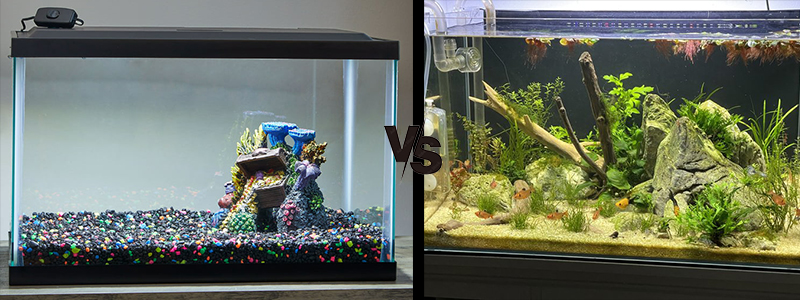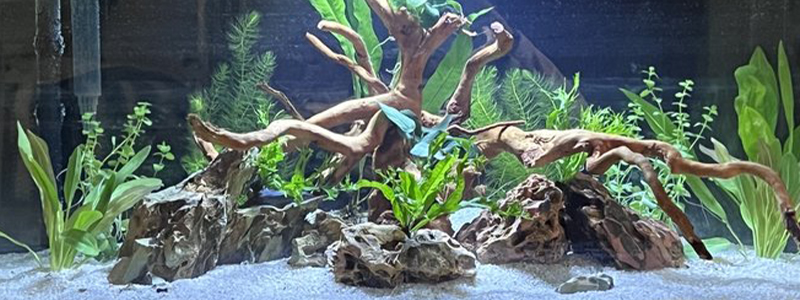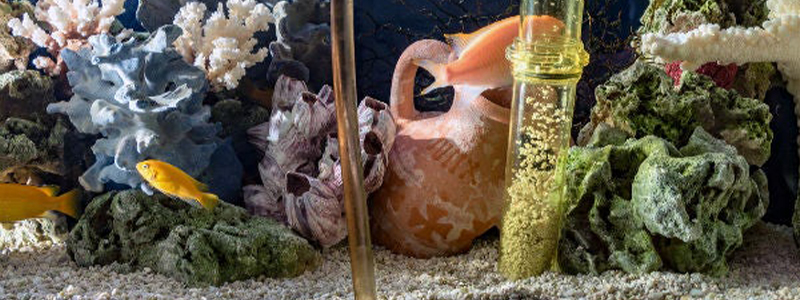Are you ready to jump into the wonderful realm of different types of Platy fish?
These stunning creatures from Central America are a preferred selection for avid aquarium hobbyists, due to their vibrant hues and low-maintenance needs.
Let’s begin this exciting journey as we delve deeper into the different types of platy fish in our amazing and comprehensive guide.
Disclosure: This article contains affiliate links. When you follow a link to purchase the products, I sometime earn a commission, at no additional cost to you. Read my full disclosure here
Quick Overview
| Scientific Name |
Xiphophorus maculatus |
| Common Names | Platy fish, moonfish, southern platy fish |
| Diet | Omnivore |
| Care Level | Very Easy |
| Activity | Moderate |
| Lifespan | 3-5 years |
| Temperament | Peaceful |
| Tank Level | Mid and Top Level |
| Minimum Tank Size | 10 gallon |
| Temperature Range | 64 ° to 77 °F |
| Water Hardness | 20-25KH |
| pH | 7-8.2 pH |
| Filtration | Moderate |
| Water Type | Freshwater |
| Breeding | Livebearer |
What is Platy Fish?
The Platys, scientifically referred to as Xiphophorus fishes, are vibrant freshwater creatures that don’t possess the distinctive “sword” tail.
All of the different types of platy fish have various interesting characteristics. The one that makes platies unique is giving birth to live young, which they share with other members of the Poeciliidae family such as guppies and mollies.
Originating from the eastern shores of Central America and southern Mexico, the different types of platy fish feature along with their fascinating origin story. This makes different types of platy fish highly sought after by aquarium enthusiasts.
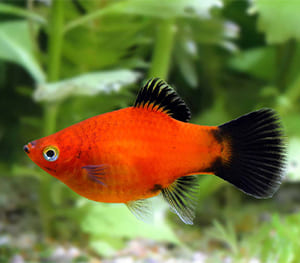
The 10 Different Types of Platy Fish
It’s not just the colors of platies that matter, but also their patterns. Different types of platy fish are differentiated from one another through their unique features.
For instance, Platies with black fins at the back and on top are known as “wagtail.” While Platy Neon Blue Wagtail has stunning neon blue and rosy gray scales complemented by black fins and tail.
Here we have mentioned the 10 best different types of platy fish. Have a look!
High fin Platy Fish
The high fin platy fish refers to those that have been specifically bred to have longer dorsal fins. While you can find high fin platy fish in the usual colors, it is less common to come across ones with intricate patterns.
However, high fin platy fish have elongated fins which impact their swimming abilities, indicating that these unique variations of platy fish prefer gentler water currents.
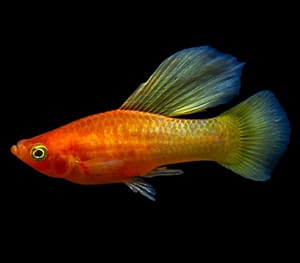
Dalmatian Platy
The Dalmatian platy fish, known for its distinctive look, has a white body covered in black spots. While it may not bring bright colors to the tank, its eye-catching black-and-white pattern is quite captivating. Like all other platies, Dalmatians prefer living in groups of at least six individuals. However, it’s recommended to keep them separate from other types of platy species.
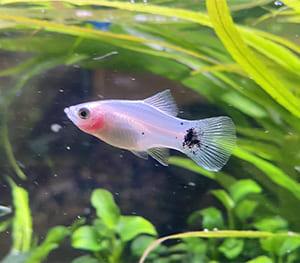
Mickey Mouse Platy Fish
The Mickey Mouse Platy fish is known for its red and blue color variations, which got it named after Disney’s iconic character.
This Mickey mouse platy fish enjoys breeding easily, grazing on plants, and can adapt to different water conditions and food sources. The Tricolor Mickey Mouse Platy fish stands out with its vibrant colors alongside the distinctive tail mark.
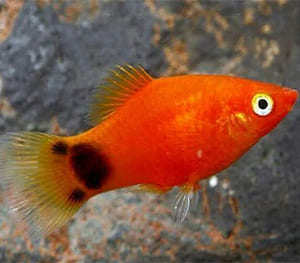
Rainbow Platy
The rainbow platy fish are known for their beautiful and vibrant colors that shine when under the aquarium lights. The rainbow platy have tails in black and heads in pale color creating a striking contrast, making them visually appealing.
Rainbow platy active fish are highly favored by those who want to have a wide range of colors in their tank, especially because their shimmering iridescence becomes even more prominent when they swim together.
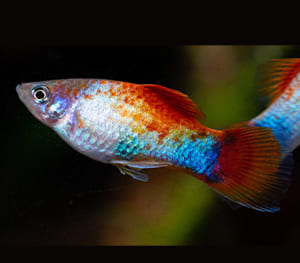
Malibu Sunset Platy
The Malibu sunset platy has a unique body color that is divided into two tones. The front part of its body has a shiny silver shade with subtle hints of blue, while the rear transitions smoothly into a vibrant orange hue.
This beautiful blend of colors extends to its fins as well, creating a perfect balance and enhancing the overall beauty of any aquarium setup.
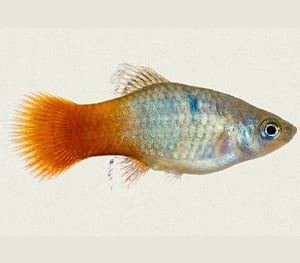
Tuxedo Platy Fish
The Tuxedo platy fish is known for its elegant color combination, resembling a tuxedo. It has a beautiful black tail and a unique hue on its front section. There are different variations of this tuxedo platy fish, including Tuxedo platy red, Tuxedo platy Copper Green, Tuxedo Platy Hifin, and Tuxedo platy Yellow.
Each variation comes with its own distinctive shades. These peaceful tuxedo platy fish thrive in aquariums with plants and get along well with larger calm invertebrates.
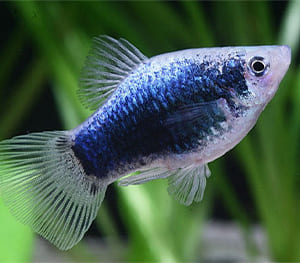
Black Hamburg Platy
The Black Hamburg platy fish are mostly black, with clear fins and a pale orange head and belly. Even though they have a dark appearance, these fish look absolutely stunning under the aquarium lights. They create dazzling reflections that mesmerize anyone watching as they elegantly glide through the tank.
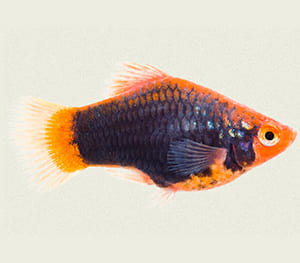
Platy Fish Swordtail Hybrid
The previously mentioned types fall under the group of platy fish found in the southern region, whereas platy fish swordtail hybrid are separate species.
Although platy fish swordtail hybrid may look similar, there are genetic variations that differentiate them. Platy fish swordtail hybrid have a longer base on their tail fins, which is an attractive feature commonly seen in pet stores.
Taking care of a platy fish sword tail hybrid is generally similar to caring for southern platies, with the only difference being their slight preference for slightly warmer water.
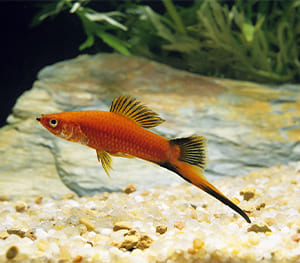
Salt and Pepper Platy
Salt and pepper platies are perfect for beginners since they don’t require any particular care. These fish get their name from the random black spots on their colorful scales.
The color beneath these spots can vary, depending on what colors are available at your local fish store.
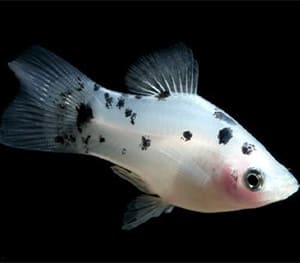
Red Wagtail Platy
The red wagtail platy is a small fish that typically measures around 1 to 2 inches in size. It stands out with its vibrant red body and distinct black fins. Sometimes, you may even notice some yellowish hues on their bellies, which adds an extra touch of beauty to this color variation.
This particular variant is quite common and always manages to capture attention.
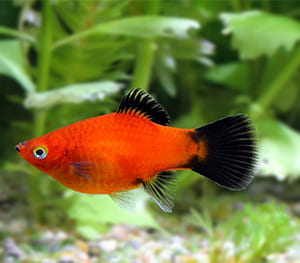
How to Choose Platy Fish from Platy Fish Varieties?
Here are the key factors that you must keep in mind before choosing Platy from platy fish varieties;
Variety of Shades and Designs: Platy fish varieties offer an extensive range of colors and patterns, allowing you to personalize the visual appeal of your aquarium.
Behavior and Compatibility: Pay attention to the behavior of platy fish varieties to ensure compatibility with other tank mates. Avoid overcrowding and maintain a well-balanced environment.
Essential Care Tips: Although care is generally consistent, it’s important to consider specific needs based on age and gender. Keep a balanced male-female ratio of platy fish varieties and adjust diets accordingly.
Breeding Considerations: If breeding is part of your plans, choose platy fish varieties that possess desirable traits.
By selecting the appropriate platy fish varieties, you can enhance the overall charm of your tank while promoting a thriving aquatic community.
Changing Platy Fish Colors: Nature’s Influence
Platy fish colors and patterns are influenced by factors other than genetics. Have a look at some factors that you will be surprised to know that how they contribute to the color variation of platy fish!
Diet: The vibrancy of their color is closely linked to their diet. Consuming foods that are rich in nutrients, particularly those high in carotenoids, enhances and maintains the intensity of their hues. To maximize color potential and overall well-being, platy fish varieties need to have a varied menu consisting of vegetables, proteins, and live foods.
Stress: Stress also plays a role in determining the vibrancy of platy fish colors. Providing them with a serene environment that has optimal water quality, plenty of space, and compatible tank mates is crucial.
Lighting: Additionally, proper aquarium lighting can greatly impact how we perceive the colors of these fish. It’s important to find the right balance so as not to create washed-out or dull appearances. You may consider enhancing your aquarium with an adjustable RGB light that allows you to customize the color spectrum specifically suited for showcasing your vibrant platy fish varieties.
Conclusion
To sum up, different types of platy fish are highly regarded symbols in the world of freshwater aquariums.
Their calm temperament, strength, and dazzling range of colors make them a much-loved fish in tanks.
With so many platy fish varieties to choose from, picking the ideal Platy for your aquarium is an enjoyable task that brings great satisfaction!
FAQ’s
Q1. How many types of platys are there?
Out of almost 30 different types of platy fish in the Xiphophorus genus, only three have made their way into aquariums – the platy fish, platy fish swordtail hybrid, and variatus platy fish.
Q2. What are the rare colors of platys?
Answer: One of the unique color variations in platy fish is the eye-catching Neon Gold Calico. This particular variation features a body that transitions from orange to iridescent yellow, with black specks adding to its overall beauty.
Q3. What is the most common platy fish?
Answer: The Southern Platyfish and the Variable Platy are frequently encountered platy. These two platy fish varieties have been known to mate with platy fish swordtail hybrid, resulting in a wide range of colors among their offspring.
Q4. What is the smallest platy fish?
Answer: Out of all the platy fish, the dwarf red coral platy fish is considered to be the smallest platy fish.
Q5. What is the biggest platy?
Answer: The variatus platy can grow to a maximum length of 7.0 cm (2.8 in). In the wild, these fish have an olive coloration with black patterns that are marbled or spotted on the side of their caudal peduncle.
Q6. Can you mix platy varieties?
Answer: Platies, regardless of their color or the shape of their tails, live peacefully together and mate with each other. Southern platies, variable platies, and platy fish swordtail hybrid can all reproduce with one another.

